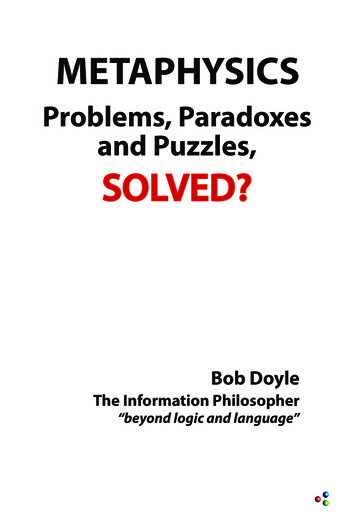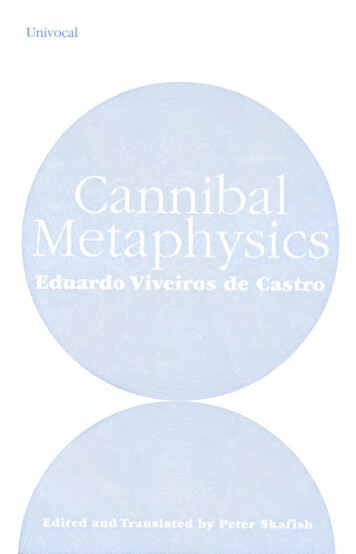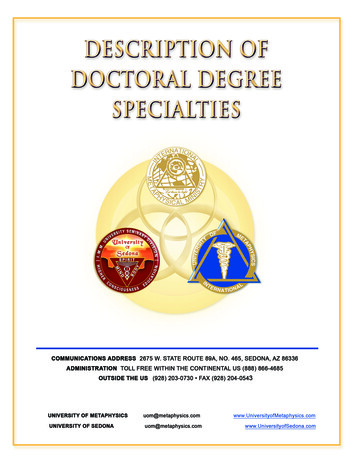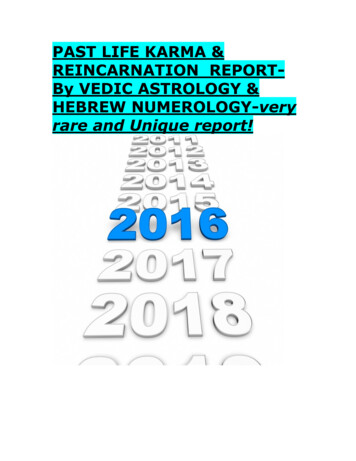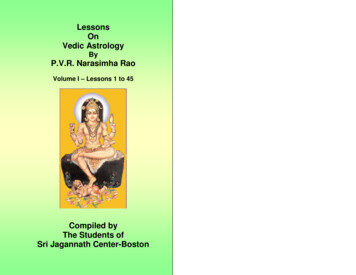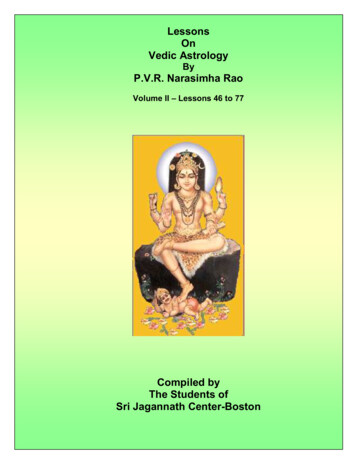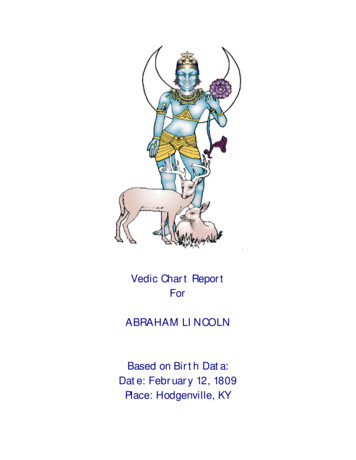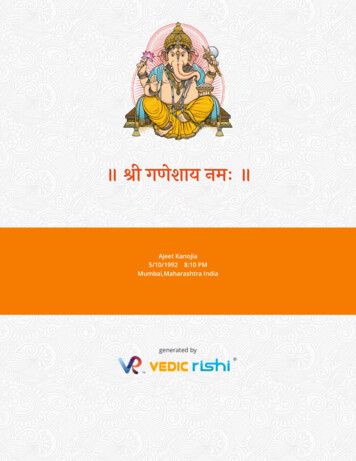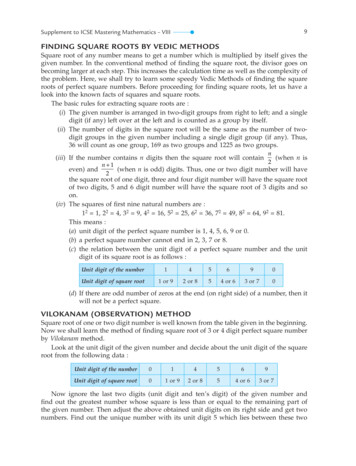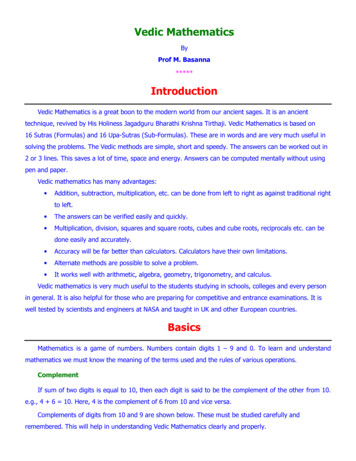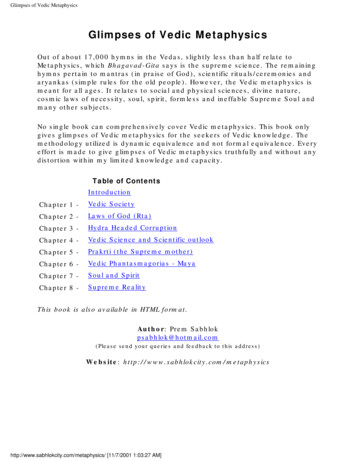
Transcription
Glimpses of Vedic MetaphysicsGlimpses of Vedic MetaphysicsOut of about 17,000 hymns in the Vedas, slightly less than half relate toMetaphysics, which Bhagavad-Gita says is the supreme science. The remaininghymns pertain to mantras (in praise of God), scientific rituals/ceremonies andaryankas (simple rules for the old people). However, the Vedic metaphysics ismeant for all ages. It relates to social and physical sciences, divine nature,cosmic laws of necessity, soul, spirit, formless and ineffable Supreme Soul andmany other subjects.No single book can comprehensively cover Vedic metaphysics. This book onlygives glimpses of Vedic metaphysics for the seekers of Vedic knowledge. Themethodology utilized is dynamic equivalence and not formal equivalence. Everyeffort is made to give glimpses of Vedic metaphysics truthfully and without anydistortion within my limited knowledge and capacity.Table of ContentsIntroductionChapter 1 -Vedic SocietyChapter 2 -Laws of God (Rta)Chapter 3 -Hydra Headed CorruptionChapter 4 -Vedic Science and Scientific outlookChapter 5 -Prakrti (the Supreme mother)Chapter 6 -Vedic Phantasmagorias - MayaChapter 7 -Soul and SpiritChapter 8 -Supreme RealityThis book is also available in HTML format.Author: Prem Sabhlokpsabhlok@hotmail.com(Please send your queries and feedback to this address)Website: abhlokcity.com/metaphysics/ [11/7/2001 1:03:27 AM]
Introduction to 'Glimpses of Vedic Metaphysics'A “Brief” To The IntroductionThe Introduction brings out briefly the various metaphysical concepts in theVedas. Since Vedic wisdom pertains to the cosmic working at all levels- frommicrocosm to macrocosm, their metaphysics comprehensively covers material,temporal, secular, spiritual and divine knowledge. In the material knowledgethere is a mention of global trade for the welfare of mankind and need tomanufacture fast moving aircrafts, vehicles and ships by the industrialists withthe help of scientists. In the other areas there is a mention of establishing anideal society where individuals following four divine professions (chatavar Varnaasharam) are predominant. When the majority of individuals follow non-divineprofessions (avarna), society tends to become perverted. The Vedic universaleducation system is meant to allocate these divine professions based on one’saptitude, merit and ability. No hymn in the Vedas mentions that Brahman,Kashtriya, Vaish and Shudra Varna are based on birth.Vedic religion is a spiritual science that aims at creating scientific outlook insociety. Idol worship, belief in savage myths and aimless rituals are not advised.Dharma is Rta- the cosmic laws of social, moral and physical order. Havingcreated these laws, even formless and ineffable God follows these laws sternly.The subtle divine Nature (Prakrti) is our supreme Mother. She is described asMaha Maya- the creator of phantasmagoria. Maya creates a golden disc andunder its vehement effect the human senses find this phenomenal world as real.The main Vedic concepts like enlightened liberalism based on the philosophy ofidd nan mmam- nothing for self all for society, need to create scientific outlook inthe society, difference between soul and spirit, personal and impersonal Godhave been briefly mentioned. Since the focal point in Vedas is the individual andhis/her welfare, all the metaphysical concepts are in this background. The Vedichymns were formulated about 5 to 6 thousands years ago. However, these werecompiled in three Vedas (treyi) more than three thousands years ago when DarkAge (Kaliyuga) already existed. The fourth Atharva Veda was compiled muchlater. Their metaphysics is even more relevant today as the cosmic Dark Age isnow nearing its peak. Naked materialism has spread its tentacles in many areasleading to hydra headed corruption, glamorization of social criminals and spreadof social, moral and physical pollution. It is also penetrating very fast into fakespiritualism and there is a large-scale rise of false prophets, fundamentalists andsycophants.Introduction“Let noble thoughts come to us from all sides.” R.V. 1-89-1Being a former student of Political Science and Philosophy, on retirement fromIndian Defence Accounts Service, I tried to revive my earlier interest in thepolitical philosophy of Plato, Aristotle, Kautilya and many other lovers of wisdomand steadily drifted towards metaphysics that Bhagavad Gita says is the supremescience. During the drift I came across a few very unusual but interestingstatements. It was even more significant to know their political and /introduction.html (1 of 15) [11/7/2001 1:03:36 AM]
Introduction to 'Glimpses of Vedic Metaphysics'views relating to God, soul, Nature, phantasmagoria- the illusory world of sensesand many other subjects.Plato mentions in his Laws (174-f) and also in Utopia that in an ideal state therange of economic disparities should be within 1:16. If the range of disparityincreases marginally, the state is less ideal. However, if it increases considerably,the state is either a Democracy or an Oligarchy. The rulers in both tend to betyrannical, corrupt, and hypocritical. In his metaphysics, Plato says that the soulof virtuous people becomes lighter and goes toward heaven by moving upwardafter death and that of the non-virtuous, being heavier, stays near the earth andis the cause of rebirth. On rebirth, people may be born in families professingdifferent faiths, religions, as well as in the different regions of the earth. Platothus becomes one of the few ancient philosophers who gave a philosophicaltheory on secularism and universal brotherhood.Again, he has mentioned that in an ideal state, which he described as Republic,divine guidance is the maximum and in Tyranny it reaches a minimum and worlddissolution comes when that divine guidance is totally withdrawn. Plato’sobservation of 1:16 immediately connected my thought process with thephilosophical views of Mahatma Gandhi who used to say that in an ideal state i.e.Ram Rajya, the income disparities between the rich and the poor should bebetween 1:10. The actual disparities in India are now much beyond 1:1000 andstill going up. If this trend continues for India, the Gandhian Ram Rajya willremain a utopia. Aristotle did not suggest any such ratios but like many otherGreek philosophers recommended the concept of “ golden mean ”. Buddha hadalready advised the “ middle path “. The Vedas and Bhagavad Gita stronglyadvise moderation for an ideal way of life to achieve perfection.This drift from political philosophy to metaphysics continued till I came acrossvastly different schools of Indian philosophy popularly known as the SadDarshana and found that all the six schools are based on the Vedas andUpanishads thus creating unity in diversity. During this search from politicalphilosophy to the Vedic metaphysics one wonders whether these lovers ofwisdom like Socrates, Plato, Immanuel Kant, Yajnavalkya, king Janaka,Sankracharya, Ramanujam and many others were ordinary human beings ordevas (shining ones) as mentioned in the Vedas. Throughout my life I avoidedreading the scriptures, fearing that I might become a fanatic or fundamentalist orlive in a world of hallucination. However, I would read the celestial songBhagavad Gita occasionally, as I did not find any organized religion there. It is adidactic book mainly on spiritual science containing an ethical social philosophyrelating to Nishkam Karma- action without any self- interest.After retirement, I made an attempt to study certain other scriptures particularlythe holy Koran in Urdu script (Roshan Chiragh) and its English translation by N.J.Dawood one of the Penguin classics. In 1997, Dr. M.H Siddiqi of Islamic Societypresented Holy Koran-English Translation of “The Meanings and Commentary”and the same was studied along with the notes. Other scriptures studied wereOld and New Testaments, a few Upanishads, Patanjali’s Yoga Shastra and fourVedas (English translation by Arya Pratinidhi Sabha and also a few volumestranslated by Swami Satya Prakash Saraswati). A large number of other books ion.html (2 of 15) [11/7/2001 1:03:36 AM]
Introduction to 'Glimpses of Vedic Metaphysics'philosophy and metaphysics mostly obtained from various libraries particularly,Lal Bahadur Shastri National Academy of Administration, Mussoorie, Institute ofAdministration, Guwahati, Central Government Libraries Shastri Bhawan and R.K.Puram, New Delhi. Most of the didactic books mentioned that the highestscriptures of Hindus are the Vedas.Surprisingly none of the scriptures and the books on philosophy and metaphysicsrefers to various types of religions now being practiced in India and abroad.Probably the soul of the scriptures is now missing in these ritualistic andorganized religions prevalent throughout the world. The study of Vedas wouldreveal that the Vedic religion is a spiritual science, where as in the present Hindureligion there is hardly any spirituality or science and the dominant visiblefeatures are blind faith, superstitions, rituals, worship of money, matter andidols.Although the roots of Hinduism lie in the Vedic religion and metaphysics, a closescrutiny would reveal a wide deviation. Vedic concepts like Rta - cosmic laws ofsocial and moral order, “Idd Nan Mmam” - nothing for self, all for the society, therole of Prakriti- the divine Nature in the creation of animate and inanimate lifeunder the supervision of God and many others, are hardly seen in the organizedHindu religion today. In the Vedas, the God is Aja (unborn) i.e. there is noincarnation of God as a human being, no worship of God through idols, He beingformless, omnipresent and ineffable. The Vedic metaphysics has a strikingresemblance with the holy Koran and Grantha Sahib. The most sacred scriptureof the Sikh religion Grantha Sahib says,”Ved, Kitab kaho mat jhoote, jhoota wohjo na vichare.” Do no say that the Vedas and the holy Koran are not truescriptures; the individual who does not study them is an untruthful person. It alsosays, “asankh garantha mukhi Ved path ”- there are innumerable scriptures butthe highest and most sacred are the Vedas.The study of various Hindu scriptures revealed that the most sacred Hinduscriptures are the Vedas and Upanishads. Next in importance are, BrahmaSutras, Smritis, Puranas, Ithasa or epics i.e. Ramayana and Mahabharata and thelastly the Tantras and a large number of minor later scriptures like, HanumanChalisa, etc. This precedence of importance is not uniform for all the Hindus asfor some Ramayana or Mahabharta could be more important than Smritis andBraham Sutras. Bhagavad Gita is partly based on the Vedic metaphysics; hencesome learned Hindus consider it as one of the Upanishads.However, by and large the authority of all the Hindu scriptures is thussubordinated to the Vedas which as a whole are Karma Marga i.e. path of selflessaction - nothing for self all for society. The Vedic metaphysics is Jnan Marga i.e.the path of knowledge. This knowledge brings out clearly the ultimatesignificance of all material and spiritual things. The Vedic Rsis and Munnies(metaphysicists and wandering sages) had found the substantial essence of allthese things in the scheme of Reality, thereby unifying the absolute Truth. Vedashave a concept of absolute and perfect truth against material and imperfecttruth. Material truths being imperfect are never permanent. The Vedic science ofAxiology covering idealistic, ideational and sensate values is entirely based onpermanent truths in the form of Rta, which are the cosmic laws of social tion.html (3 of 15) [11/7/2001 1:03:36 AM]
Introduction to 'Glimpses of Vedic Metaphysics'moral order. Yajur-Veda 7-14 clearly brings out that the noble thoughts made theculture of the Vedas the first and foremost foundations of the edifice of universalvalues. Through the Vedic mantras (poetical hymns) homage is paid to the Rsisof the yore, path makers and pioneers (R.V 10-14-15 and A.V 18-2-2). MundakaUpanishads 1-1-3 mentions that having known Vedanta, all other knowledge willstand revealed to us. Vedas are thus the acme of human thought and themetaphysics reaches its summit in the Vedantic philosophy contained in thefourth and last part of the Vedas in the form of pure idealism and absolutemonism. Vedas are also known as Shruti - the heard. Most of the modern Hindusbelieve that God directly revealed the Vedas.Vedic wisdom covers the Cosmic working at all levels, from microcosm tomacrocosm. It covers material, temporal, secular, spiritual, and divine knowledgeby blending both the inner and outer worlds. In the concept of Brahma as theonly Reality, the highest metaphysical ethics is reached as all else is Maya(appearance or phenomenon but not exactly mirage). Maya is His Creative Art(R.V 6-45-16 and 6-47-18). Isvaraya Upanishad explains this as the illusory butblindingly brilliant disc, which appears real to human senses. Holy Koran alsoconfirms that life in this vast ocean of matter- the material world is an illusion ofcomfort. New Testament also says that man is like a breath and his days arepassing shadows. Plato held largely similar views in his theory of Forms andIdeas. Immanuel Kant described the phenomenal material world asphantasmagoria.However, the great Indian saint and philosopher Sankracharya explained thisconcept of Nature and universe as Maya in great details in his Brahma Sutras.First he made a clear distinction between para jnan (higher knowledge) andapara jnan (lower knowledge). He called the knowledge of senses, matter,physical body and the outer world as lower knowledge or Avidya. With thisknowledge the entire universe looks “real.” Individuals with lower knowledge willfind a lot of arguments in favour or against the existence of God. He called it apeculiar phenomenon of human senses.
Surprisingly none of the scriptures and the books on philosophy and metaphysics refers to various types of religions now being practiced in India and abroad.


